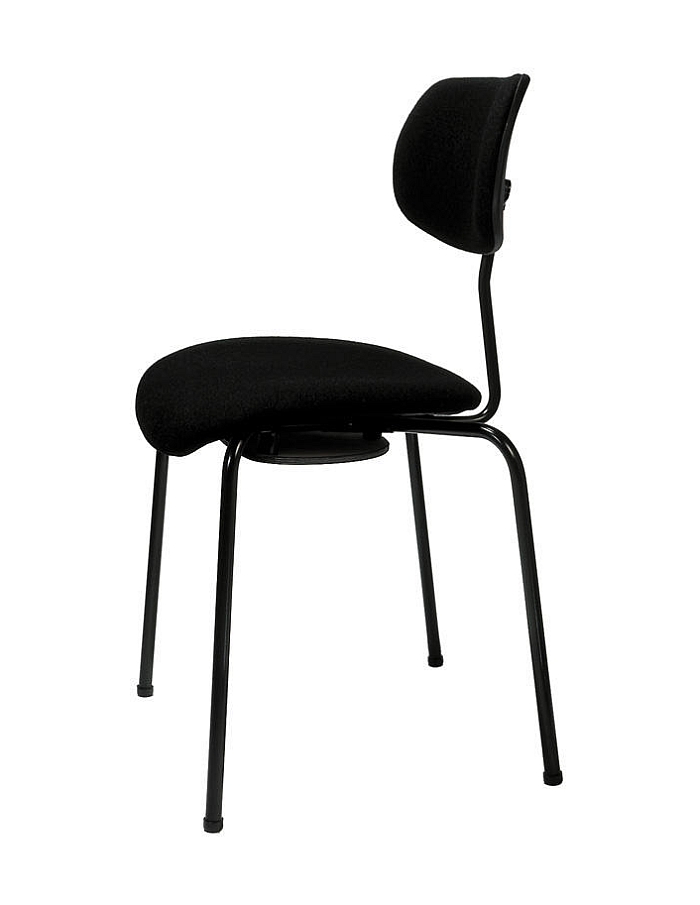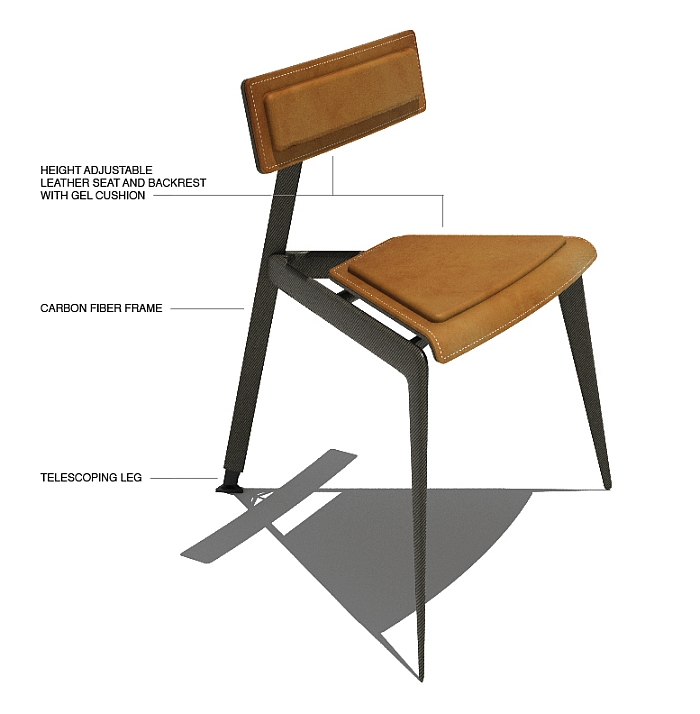The Sedentary Workers: Orchestra Musicians
Although the evidence is not, yet, conclusive, recent years have seen an increasing confidence in the theory that sitting for too long can have a negative impact on health, and that all whose job involves prolonged sitting should regularly stand, move and generally change their body position.
But what about those workers who can’t? What about those workers whose job is defined by long periods of sitting?
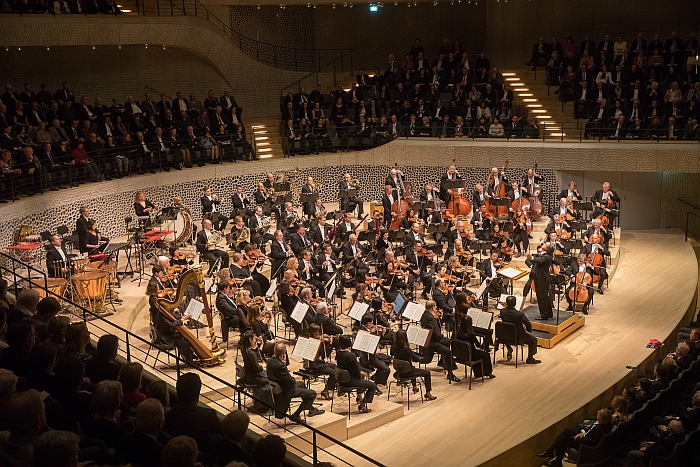
Orchestra musicians at work. Seated. Specifically, the Chicago Symphony Orchestra with Riccardo Muti at the Elbphilharmonie Hamburg, January 2017 (Photo © Todd Rosenberg, Courtesy Elbphilharmonie Hamburg)
Whereas not every office worker has access to a height adjustable desk or a 3D swivel office chair, every office worker has numerous options to incorporate regular movement and changes of body position into their working day: walking to a colleague rather than telephoning/skyping, placing folders and files out of arms reach so that you have to move to get them, holding meetings standing rather than sitting, being amongst the simplest solutions. That many don’t is pure bad habit. But the options are there.
There are however those professions where such options aren’t there, where sitting is the only option, and of which the professional orchestra musician is arguably the best example: quite aside from regular, and often long, concerts and performances, there is the hours of rehearsals.
Yet despite the fact orchestra musicians spend, more or less, their entire professional lives seated, not only is the seated musician a much less researched subject than the seated office worker, but the musician’s chair an object of much less design interest than the office chair. Or even the dining chair.
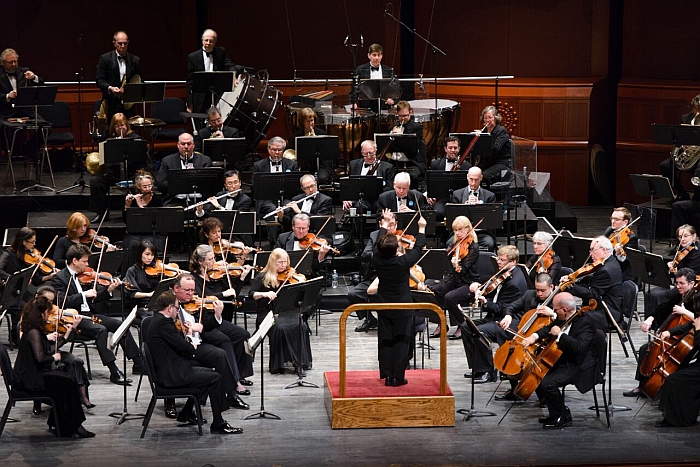
New Jersey Symphony Orchestra at the New Jersey Performing Arts Center, Newark (Photo © Fred Stucker, courtesy NJSO)
The Seated Musician
In the contemporary orchestra aside from the percussionists, and arguably the perching double bassists, all instruments are played seated. And that rarely in manners conducive to good health: the nature and demands of the profession meaning that musicians are susceptible to a wide range of, potentially career threatening, physical and psychological conditions.
A particular problem is musculoskeletal conditions associated with both the repetitive actions involved with playing many instruments and the less than optimal postures demanded, specifically in context of instruments played in so-called asymmetric positions, for example with raised arms. Among other surveys Leaver et al1 noted in 2011 that over half of respondents from 6 British orchestras had experienced lower back, neck or shoulder pain in the previous 12 months, in 2015 Steinmetz et al2 found a similar situation amongst professional orchestra musicians in Germany, while a 2009 study of Swedish music teachers by Edling and Fjellman-Wiklund3 concluded that those with asymmetric playing positions reported significantly higher levels of neck, shoulder and back disorders than their colleagues with symmetric playing positions.
Research on causal factors of musicians’ muscular complaints tend to focus on measuring the significance of variables such as age, gender, length of career, instrument type, diet or somatisation, the transfer of psychological stress into physical discomfort.
The chair all musicians sit on rarely coming under investigation.
Yet when it does the results can be very illuminating.
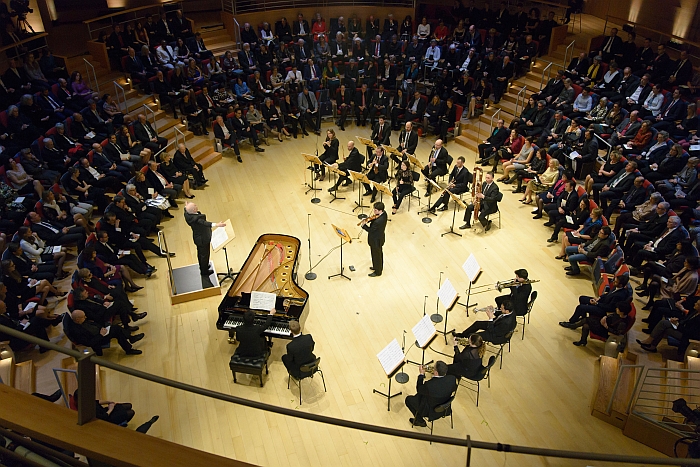
The Boulez Ensemble Berlin, the musicians bottom right demonstrating some of the typical seating positions musicians adopt: uptight against the backrest, sitting on the front edge, somewhat slouched with extended legs….(Photo © Peter Adamik, Courtesy of Wilde+Spieth)
The Musician’s Chair
The first, and, and as far as we can ascertain, for many years the only study of orchestra musicians to consider the chair, was published in 1986 by a team from the Institut für Arbeitsmedizin at the Freie Universität Berlin (Schäcke et al)4. Based on a survey of 109 members of an otherwise unnamed opera orchestra, Schäcke et al reported that 51.4% were unhappy with their chair, specifically with the backrest, upholstery, seat height and seat angle. Noting that as members of the “homo sedens” musicians had no choice but to sit, and that in ways defined by their instruments, Schäcke et al put the emphasis for maintaining musician’s musculoskeletal health on their chairs and concluded that orchestra seating must take account of the postures of the different instrument groups and that anthropometric studies should be undertaken in order to generate precise information on the requirements for chairs relative to the different instrument groups. As far as we are aware, in the intervening 31 years, none has been published.
In a 2004 study of the Ljubljana based Slovene Philharmonic Orchestra Rajko Črnivec found that from the 70 musicians questioned 42% were dissatisfied with their chair, 14.5% dissatisfied with the height and 31.9% with the back support5. The greatest dissatisfaction was reported by double bassists, harpists, cellists, drummers, violinists and violists. Sadly despite having a control group of marketing workers based in a conventional office environment, he doesn’t record levels of dissatisfaction with their chairs: does however note that the rate of musculoskeletal problems amongst the musicians was six times higher than the control group. A direct relationship between sitting and the prevalence of muscular problems wasn’t made, Črnivec does however recommend the provision of ergonomic, height adjustable chairs with back support, specifically he suggests chairs labelled with the musician’s name. A personal chair much as in an office environment.
In 2015 a team from the Ergonomics Research Centre at the University of Guadalajara (Leon et al)6 published the results of a study undertaken amongst the youth bands of Zapopan and Guadalajara. The sample size was 55 and found that whereas only 15.4% used a height adjustable bench, 71.4% considered “comfortable chairs or benches” desirable. There is sadly no definition of what “comfortable” means. And, theoretically, who doesn’t want a “comfortable” chair?
Despite the relatively small number of studies – the above three are the only published research we can find – and relatively small sample sizes, one could argue that musicians are aware that their chairs aren’t exactly optimal.
The question is, can design help improve the situation?
Designing the Musician’s Chair
The only published design led study looking at the subject of the musician’s chair we are aware of was undertaken by the architect and designer David A. Brothers from the New Jersey Institute of Technology7, and is based on interviews with 40 professional musicians combined with a year long observation of orchestra and ensemble musicians both performing and rehearsing.
Among the more interesting results from David’s research is that musicians receive little advice as to how they should sit, that when practising at home most musicians just use that chair which is closest to hand, be that, for example, a dining chair or the chair that is normally used when on the computer, and that “while most musicians understand the importance of good posture for maintaining proper technique while playing, many have little awareness of the significance that chair design can have toward achieving this.”8
In addition David A. Brothers found that, “only a tiny percentage of musicians indicated that they cared about what their chairs looked like”9. A state of affairs which, when one considers both that orchestra music belongs to the highest echelons of culture, and the grace and architectural sophistication of many concert and opera houses – old and new – appears surprising. Is however independently supported by Thomas Gerber CEO of Wilde+Spieth, one of Europe’s largest producers of orchestra chairs, “musicians don’t care what the chair looks like”, he tells us, “it must be comfortable and most importantly mustn’t emit any noise.”
Which naturally got us thinking about how many office workers are concerned with the aesthetic subtleties of their chairs? We don’t think anyone has ever asked…….
Trying to reason why musicians should be so ambivalent about the formal character of their chairs we initially, tried, considering aesthetics in music versus aesthetics in visual arts, before deciding it may simply be that because they rarely receive advice on how to sit, that many accept aches and pains as part of the job10, and that, as touring musicians, more often than not simply have to use that chair which is provided by a venue, regardless of how unsuitable, many musicians may learn to understand chairs as a neutral part of the “kit”, to make do, and thus give it no consideration.
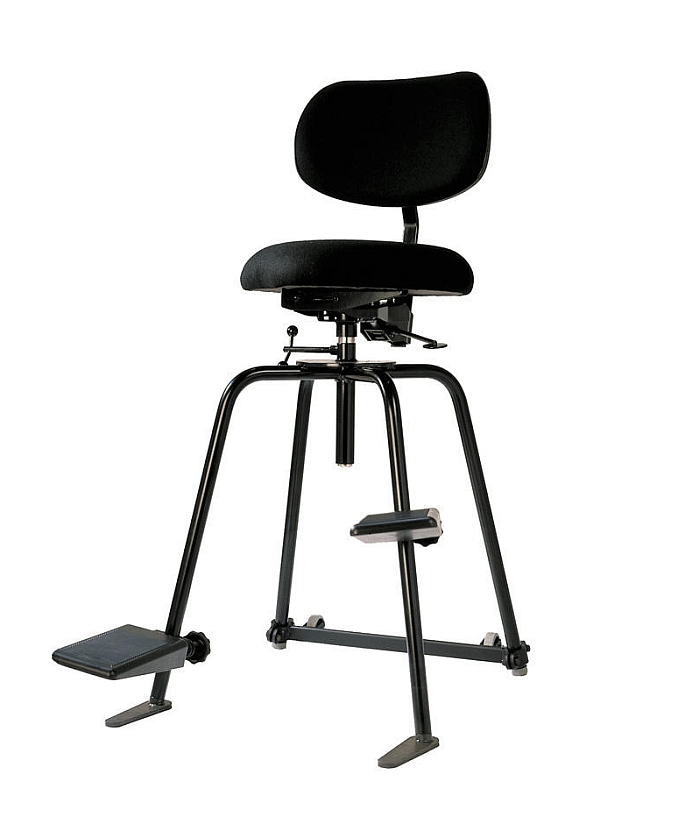
Double Bass Chair by Wilde+Spieth, a nice example of the functional necessities of an orchestra musicians chair…. (Photo © Wilde+Spieth)
The Musician’s Chair: Ergonomic Considerations
Much as there is no one perfect office chair, there can be no perfect orchestra chair, too varied are musicians and their preferences; however, David A. Brothers proposes that there are four key design factors to optimising the ergonomics of the musician’s chair: forward sloping seat, height adjustability, provision of backrests and that the chair allows for uninhibited freedom of movement.
While not surprising conclusions, in many respects they mirror the findings of Schäcke et al, the fact that not all orchestra chairs provide such, is surprising.
While backrests are generally present, if not always adjustable, and most chairs will allow for freedom of movement, if not always uninhibited or optimal, the lack of height adjustment and forward sloping seats on orchestra chairs is difficult to explain. In terms of height adjustment, musicians come in different sizes and with non-height adjustable chairs only a limited number are going to find an ideal sitting height. The rest are going to be sitting wrong. Often very wrong. While in terms of forward sloping, not only does the evidence suggest that a forward sloping seat allows for a better posture, and thus less muscular strain, for many instruments it is considered essential to ensuring correct technique. One of the highlights of our literature research was a study by a team from the School of Biosciences at Cardiff University which noted that, “while some modern orchestral chairs have been ergonomically designed to incorporate a degree of slope, the chairs that players are most often presented do not, and they may therefore adapt them by using wedge shaped cushions or by putting blocks under the back legs.”11
Imagine that in an office environment. Blocks under your chair legs to achieve an agreeable sitting position. A ridiculous state of affairs!
The Designer’s Musician’s Chair
One of the first to critically consider the musician’s chair was the German architect and designer Egon Eiermann. In 1956 Eiermann needed chairs for a concert hall project in Stuttgart, unable to find anything suitable he, in the words of Thomas Gerber, “took the SE 68, added some upholstery, and that was the chair. The musicians’ response to that chair was largely “Nice, but we need more”, which is understandable, for all when one considers that different instruments have very differing demands and require different sitting positions.”
Taking up the challenge to create that “more” Wilde+Spieth have progressively developed a range of chairs for differing instruments and playing positions, and featuring a mix of height adjustment and tilting mechanisms. Chairs initially developed in cooperation with Egon Eiermann, subsequently independently of Eiermann, but always in cooperation with musicians. And chairs which not only reflect the four design factors identified by David A. Brothers, but also musicians’ general lack of interest in visual aesthetics. Aside from the non-adjustable version based on, and, more or less, formally true, to Eiermann’s SE 68, in the Wild+Spieth chairs functionality takes priority over proportion or purity of line. The functionality is however present, unlike many musician’s chairs which lack functionality and form.
As a designer David A. Brothers is interested in visual aesthetics; consequently, from his research he developed a chair concept which in addition to the purely functional aspects also considers the form. As ever we never feel comfortable commenting on a chair we’ve never physically seen and had a chance to assess first hand; however, from what we’ve seen the triangular, carbon fibre, frame of David’s design creates a very reduced, unobtrusive object, whereby, we presume, the carbon fibre allows for the required stability with a lot less material than would normally be the case. Cutting a very clean, elegant, self-confident figure, the seat and backrest are height adjustable, the backrest in addition can be moved forward if required, while forward tilt of up to 10° is achieved through a telescopic rear leg, a very popular mechanism for achieving height adjustment in orchestra chairs. If in no other chair types. Save collapsible angling chairs intended for uneven riverbanks and lakesides.
Representing for us a welcome aesthetic improvement on what is currently available, the principle weakness is the non-stackability, an absolute key issue in the daily life of such an object. According to David this initial version was about exploring the basics of the idea through a chair intended for small scale use, for example by a quartet, a stackable version suitable for the demands of an orchestra is in development12, and we’re certainly looking forward to following how the project develops: not least because a visually pleasing, functionally responsive, chair may encourage musicians to take more interest in their chairs – or as Mark Braun opined in our recent interview, “I believe that through a good aesthetic functionality becomes longer lasting, that formal beauty creates an appreciation … when something is not only practical, but aesthetically pleasing, then you value it more and get a lot more pleasure from it“. And if more musicians value their chairs more, then maybe they will also take more interest in how their chairs can, potentially, help them maintain not only better posture, but better health.
The Sedentary Workers: Orchestra Musicians
An orchestra chair is a work chair just as much as an office chair is a work chair: albeit with a few very particular peculiarities. Quite aside from the nature of the work undertaken in it, comes the fact that, much like hotel function and conference chairs, orchestra chairs are continually being moved, arranged, rearranged and stored in response to the concert hall’s programme: facility management factors which can outweigh ergonomic considerations when deciding which chairs to purchase. Even if they shouldn’t. Further, in addition to emitting no noise themselves, orchestra chairs should not adversely affect the acoustics of the hall nor should they impact on the visual impression, should remain as anonymous as possible, must be supremely stable so as not to distract the musician with unexpected movement, and must be priced to meet concert hall, opera and orchestra budgets.
A combination of factors which, in many respects, makes orchestra chairs a lot more challenging than office chairs.
And so perhaps the greatest peculiarity of the orchestra chair is that it is of so little interest to designers. Or maybe designers don’t know orchestras exist, maybe they are all just far too busy rockin’…..
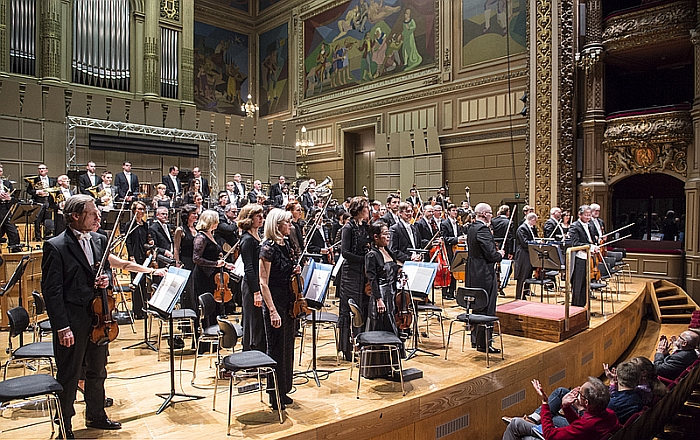
The only chance most orchestra musicians get to stand, the final bow. Here l’Orchestre Philharmonique Royal de Liège in the Salle Philharmonique Liège, March 2017 (Photo © Anthony Delhez, courtesy OPRL)
1. Leaver R. et al, Musculoskeletal pain in elite professional musicians from British symphony orchestras, Occupational Medicine, 2011;61:549–555
2. Steinmetz A. et al, Frequency, severity and predictors of playing-related musculoskeletal pain in professional orchestral musicians in Germany, Clinical Rheumatology, 2015;34:965–973
3. Edling C.W. & Fjellman-Wiklund A., Musculoskeletal Disorders and Asymmetric Playing Postures of the Upper Extremity and Back in Music Teachers. A Pilot Study, Medical Problems of Performing Artists, 2009;3:113-118
4. Schäcke G, et al: Muskel-Skelet-Bechwerden bei Orchester-musikern. Fortschritte Med 1986;6:126-128.
5. Črnivec R., Assessment of Health Risks in Musicians of the Slovene Philharmonic Orchestra, Ljubljana, Slovenia, Medical Problems of Performing Artists, 2004;3:140-145
6. León L. et al., Human Factors in Musicians: Design Proposals, Procedia Manufacturing, 2015;3: 6124 – 6132
7. David A. Brothers, The Seated Musician: Furniture Design and its Effect on Performance and Health, Proceedings 10th Hawaii International Conference on Arts & Humanities, 2012 1319-1336
9. http://www.njit.edu/features/sceneandheard/orchestra-seats.php
10. see, e.g. Ioannou C. & Altenmüller E., Approaches to and Treatment Strategies for Playing-Related Pain Problems Among Czech Instrumental Music Students. An Epidemiological Study, Medical Problems of Performing Artists2015;30:135-142 or Kreutz G. et al, Music Students’ Health Problems and Health-promoting Behaviours, Medical Problems of Performing Artists 2008;23:3–11.
11. Price K. et al, The effect of standing and sitting postures on breathing in brass players, SpringerPlus 2014; 3:210
Tagged with: David A. Brothers, Egon Eiermann, Frankfurt, Musician's chair, New Jersey Institute of Technology, Newark, Orchestra chairs, Seating, wilde+spieth
